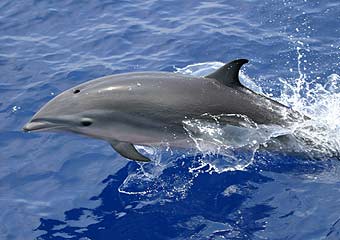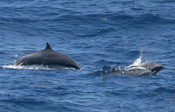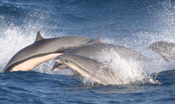Fraser's Dolphin (Lagenodelphis hosei)
Status | Taxonomy | Species Description | Habitat | Distribution |
Population Trends | Threats | Conservation Efforts | Regulatory Overview |
Key Documents | More Info
 Fraser's Dolphin (Lagenodelphis hosei) Photo: Robert Pitman, NOAA |
|
Did You Know? · Fraser's dolphins were first described in 1956, but were not documented in the wild by scientists from the Western world until 1971. |
|
 Fraser's Dolphin (Lagenodelphis hosei) Photo: Sophie Webb, NMFS Southwest Fisheries Science Center |
Status
MMPA - Fraser's dolphins, like all marine mammals, are protected under the MMPA.
Taxonomy
Kingdom: Animalia
Phylum: Chordata
Class: Mammalia
Order: Cetacea
Family: Delphinidae
Genus: Lagenodelphis
Species: hosei
Species Description
Fraser's dolphins are members of the delphinid family. They are about 6-9 feet (2-2.7 m) long and weigh 350-450 pounds (160-210 kg). Males are generally slightly longer, weigh more, and have more distinct color patterns than females.
They have a stocky or chunky body with a postanal hump and a small distinct beak. The dorsal fin located midway down its back is small, slightly falcate, and triangular in shape. The flippers and flukes are small when compared to other dolphin species.
Fraser's dolphins are recognized by a distinct dark (usually black or gray) lateral flank stripe that extends from their eye to their flipper and anus and reminds some people of a "raccoon" or "bandit"-like mask. The stripe may vary based on geography and gender. The upper-part of the animal is a bluish or brownish gray and the underside is usually pale white or pink. The color pattern is generally duller and less striking in calves, but varies individually based on sex and age.
Fraser's dolphins are usually found in large tight groups averaging between 10-100 individuals, but have been occasionally seen in larger groups of up to 1,000 or more animals. They are sometimes seen in mixed schools associated with other cetacean "blackfish" species such as false killer whales, melon-headed whales, Risso's dolphins, and short-finned pilot whales (Shirihai and Jarrett 2006). Terns (a type of seabird) are sometimes associated with these animals when feeding at the surface.
Their swimming behavior is often described as low-angled, aggressive, and splashy, creating a distinctive frothy wake. Groups of individuals sometimes form long bunched lateral "chorus" lines. Depending on the geographical area, Fraser's dolphins can be timid and elusive, or approachable and gregarious when interacting with vessels.
Fraser's dolphins are capable of diving up to almost 2000 feet (600 m) to feed on deep sea species of mesopelagic fish (e.g., myctophids), crustaceans (e.g., shrimp), and cephalopods (e.g., squid and octopus). They have 20-44 pairs of small conical teeth in each jaw that are useful for grasping their prey.
They become sexually mature and begin breeding between 5-10 years of age (females at 5-8 years, males at 7-10 years). After a gestation period of 10-12.5 months, females give birth to a single 3.3 feet (1 m) long calf every 2 years usually between spring and autumn. Their estimated lifespan may be 18 years or more.
 Fraser's Dolphin Range Map (click for larger view PDF) |
Habitat
Fraser's dolphins occur in warm temperate, subtropical and tropical pelagic waters usually deeper than 3,300 feet (1000 m) worldwide. They are often associated with areas of upwelling.
Distribution
Fraser's dolphins have a cosmopolitan distribution from 30° South to 30° North, and live in deep, tropical waters. They can occur in areas near coastlines where the continental shelf is narrow. Stranded Fraser's dolphins have been reported outside their typical range in southern Australia, France, western Scotland, and Uruguay (Shirihai and Jarrett 2006).
 Fraser's Dolphin (Lagenodelphis hosei) Photo: NMFS Southwest Fisheries Science Center |
Population Trends
For management purposes, Fraser's dolphins inhabiting U.S. waters have been divided into three stocks: the Hawaiian Stock, the Northern Gulf of Mexico Stock, and the Western North Atlantic Stock. The Hawaiian stock is estimated between about 8,000 and 19,000, while the population in the northern Gulf of Mexico is estimated between 400-700 animals. The population size in the western North Atlantic is unknown due to insufficient data available on current population trends. In the eastern tropical Pacific Ocean, scientists estimate there are at least 100,000-289,000 animals. The worldwide population of Fraser's dolphins is unknown and for the most part not considered very abundant.
Threats
Fraser's dolphins have been incidentally "taken" as bycatch in fisheries operating in pelagic waters such as driftnets, gillnets, and trap nets. Specifically, Fraser's dolphins have been incidentally captured in tuna purse seine fisheries in the eastern tropical Pacific and the Philippines. Furthermore, Fraser's dolphins have also been directly targeted and killed by fisheries in Indonesia, Japan, the Lesser Antilles, the Philippines, and Sri Lanka for meat and oil (Jefferson et. al. 2008).
Conservation Efforts
The IUCN Red List of Threatened Species ![]() considers Fraser's dolphins as "Data Deficient" due to insufficient information on population status and trends.
considers Fraser's dolphins as "Data Deficient" due to insufficient information on population status and trends.
Regulatory Overview
This species is protected under the Marine Mammal Protection Act of 1972 as amended.
Key Documents
(All documents are in PDF format.)
| Title | Federal Register | Date |
|---|---|---|
| Stock Assessment Reports | n/a | various |
- Listen to Fraser's Dolphin Sounds
- IUCN Fraser's Dolphin Species Information

- Ocean Biogeographic Information System (OBIS-SEAMAP) Fraser's Dolphin Species Profile

References:
- Jefferson, T. A, M. A. Webber, and R. L. Pitman. (2008). Marine Mammals of the World, A Comprehensive Guide to their Identification. Amsterdam, Elsevier. p. 253-256.
- Shirihai, H. and B. Jarrett (2006). Whales, Dolphins and Other Marine Mammals of the World. Princeton, Princeton University Press. p.197-198.